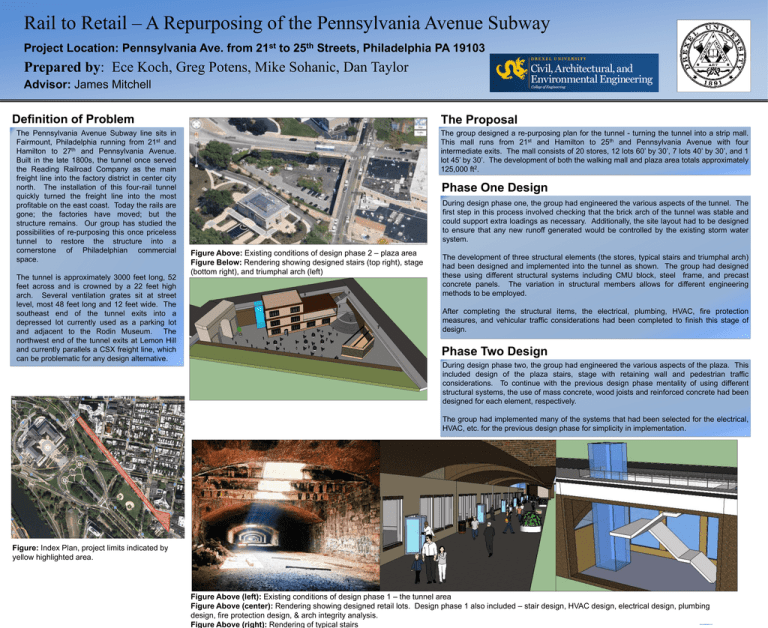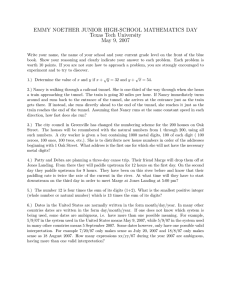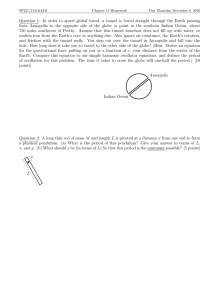Rail to Retail – A Repurposing of the Pennsylvania Avenue... Prepared by Definition of Problem The Proposal
advertisement

Rail to Retail – A Repurposing of the Pennsylvania Avenue Subway Project Location: Pennsylvania Ave. from st 21 to th 25 Streets, Philadelphia PA 19103 Prepared by: Ece Koch, Greg Potens, Mike Sohanic, Dan Taylor Advisor: James Mitchell Definition of Problem The Pennsylvania Avenue Subway line sits in Fairmount, Philadelphia running from 21st and Hamilton to 27th and Pennsylvania Avenue. Built in the late 1800s, the tunnel once served the Reading Railroad Company as the main freight line into the factory district in center city north. The installation of this four-rail tunnel quickly turned the freight line into the most profitable on the east coast. Today the rails are gone; the factories have moved; but the structure remains. Our group has studied the possibilities of re-purposing this once priceless tunnel to restore the structure into a cornerstone of Philadelphian commercial space. The tunnel is approximately 3000 feet long, 52 feet across and is crowned by a 22 feet high arch. Several ventilation grates sit at street level, most 48 feet long and 12 feet wide. The southeast end of the tunnel exits into a depressed lot currently used as a parking lot and adjacent to the Rodin Museum. The northwest end of the tunnel exits at Lemon Hill and currently parallels a CSX freight line, which can be problematic for any design alternative. The Proposal The group designed a re-purposing plan for the tunnel - turning the tunnel into a strip mall. This mall runs from 21st and Hamilton to 25th and Pennsylvania Avenue with four intermediate exits. The mall consists of 20 stores, 12 lots 60’ by 30’, 7 lots 40’ by 30’, and 1 lot 45’ by 30’. The development of both the walking mall and plaza area totals approximately 125,000 ft2. Phase One Design During design phase one, the group had engineered the various aspects of the tunnel. The first step in this process involved checking that the brick arch of the tunnel was stable and could support extra loadings as necessary. Additionally, the site layout had to be designed to ensure that any new runoff generated would be controlled by the existing storm water system. Figure Above: Existing conditions of design phase 2 – plaza area Figure Below: Rendering showing designed stairs (top right), stage (bottom right), and triumphal arch (left) The development of three structural elements (the stores, typical stairs and triumphal arch) had been designed and implemented into the tunnel as shown. The group had designed these using different structural systems including CMU block, steel frame, and precast concrete panels. The variation in structural members allows for different engineering methods to be employed. After completing the structural items, the electrical, plumbing, HVAC, fire protection measures, and vehicular traffic considerations had been completed to finish this stage of design. Phase Two Design During design phase two, the group had engineered the various aspects of the plaza. This included design of the plaza stairs, stage with retaining wall and pedestrian traffic considerations. To continue with the previous design phase mentality of using different structural systems, the use of mass concrete, wood joists and reinforced concrete had been designed for each element, respectively. The group had implemented many of the systems that had been selected for the electrical, HVAC, etc. for the previous design phase for simplicity in implementation. Figure: Index Plan, project limits indicated by yellow highlighted area. Figure Above (left): Existing conditions of design phase 1 – the tunnel area Figure Above (center): Rendering showing designed retail lots. Design phase 1 also included – stair design, HVAC design, electrical design, plumbing design, fire protection design, & arch integrity analysis. Figure Above (right): Rendering of typical stairs www.postersession.com






